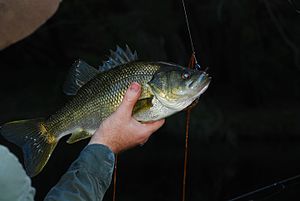Surface lure
This article does not cite any sources. (March 2007) |

A surface lure or topwater lure is a class of fishing lure that is designed to attract the attention of fish through commotion produced on the surface of the water as it is being reeled, and in doing so imitate surface prey of interest to predatory fish, such as small injured baitfish, mice, lizards, frogs, cicadas, moths, snakes and ducklings. These lures are preferred by some anglers due to the belief that they attract strikes from larger than average fish, and from the added excitement of seeing the fish strike the lure. When fish are aggressive, topwater lures may be attacked with great force. Most topwater lures float, but others must be reeled rapidly to the surface to produce the intended action.
Topwater lures come in several different styles that produce action through different movements:
Walking Baits[]
- Walkers, also called stickbaits or spooks tend to simply slide across the water surface in a serpentine fashion that resembles a prey swimming close to the surface. These lures are popular for both fresh and saltwater fishing and come in a large range of sizes.
- These lures are often streamlined and cigar-shaped and may include rattles to draw in fish from farther away. Others may include a cupped face to splash water during the retrieve. They are usually equipped with two or three treble hooks. Predatory fish such as largemouth bass have been known to come up from deep water to attack these lures. They are often cast into schools of actively feeding fish and retrieved quickly to imitate a fleeing baitfish.
- Walking baits are retrieved using a special cadence called "walking the dog," in which the angler retrieves the lure using a combination of rod twitches and reeling.
- Though mostly used to imitate baitfish, some walking baits are patterned to resemble frogs, insects, or reptiles.
Crawlers[]
- Crawlers or waddlers get their action from a scooped metal dish attached to the front of the lure body, which causes the lure to wriggle and splash in a movement reminiscent of a front crawl. Others are designed with a pair of metallic wings that unfold when the lures splashes down. In most cases, these lures a retrieved at a slow and steady pace. These are a popular style of lure for night fishing.
- In some cases, these lures may be equipped with rattles or props for additional action.
- This style of lure more closely resembles a small animal, such as an insect or baby bird, that has become trapped on the water's surface.
Poppers[]
- Poppers or chuggers get their action from a cupped face carved or molded into the front of the lure body, which funnels water towards its tail and produces turbulent bubbles and wakes behind it to imitate an injured or drowning prey. These are among the oldest types of fishing lure and come in designs suited for both conventional gear and fly fishing gear. Very large models are used for targeting saltwater species.
- Poppers are often cast to isolated cover, such as a fallen tree or patch of weeds. The traditional retrieve is to wait for the ripples to disappear and then to slowly "pop" the lure by twitching the rod tip, giving pauses in between lasting up to several seconds. They can also be cast to more open areas and worked back more rapidly. Some models can also be "walked" much like a walking bait.
Buzzbaits[]
- Buzzbaits are a type of topwater lure that does not float. They consist of a jighead with an attached wire that carries a prop of metal or plastic, along with a single hook. While most buzzbaits have two-bladed props, models with three or four blades also exist. Some have more than one prop. Lures with more blades or props can be retrieved more slowly. Buzzbaits attract fish through the commotion caused by the prop rotation, as well as the metallic squeaking sound. Some models also feature an extra clacker blade that the prop strikes against, producing a much louder noise that can sometimes attract fish from further away.
- These lures are typically cast near cover and are retrieved as soon as they hit the water to prevent them from sinking. Since they must be retrieved at a steady pace, buzzbaits can be used to cover water quickly and efficiently. Buzzbaits are often fitted with a soft plastic trailer imitating a frog or baitfish to increase action and attraction. Other anglers prefer to add a trailer hook to increase the chances of a hookup.
Prop Baits[]
- Prop baits are floating lures made of hard plastic that use one or more small propellers to attract fish. Some models have a single prop on the back, while others may have props on the front and back. Props can be made of metal or plastic.
- Depending on the model, prop baits may be retrieved at a steady pace or with a pause and twitch retrieve. They usually are designed to resemble baitfish.
Sizeable fish can cause a sudden, noisy and spectacular splash when they strike a surface lure, usually giving the fisherman a fright in the process. Catching fish on surface lures is therefore considered a fairly exciting form of fishing.
- Recreational fishing
- Fishing equipment
- Fishing stubs

